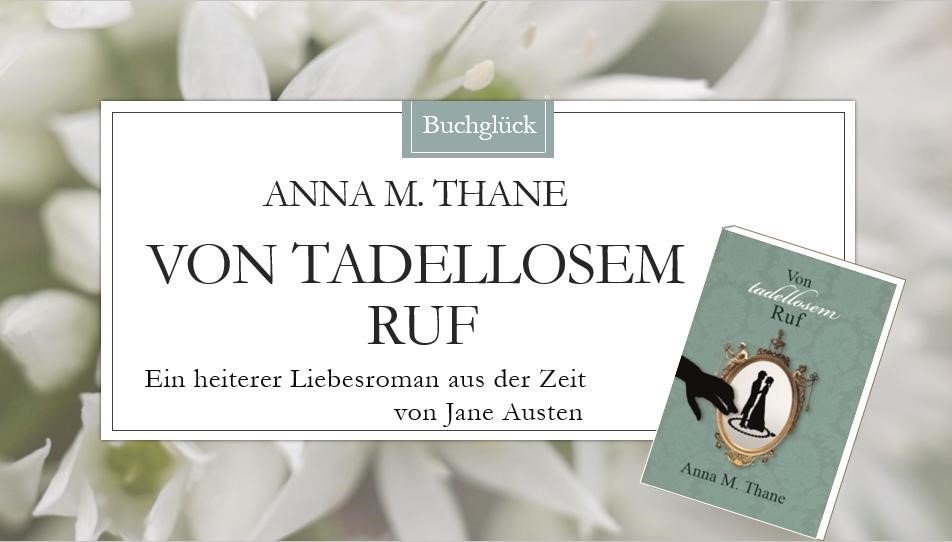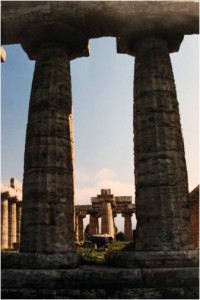 Find in this travel guide for the 18th century:
Find in this travel guide for the 18th century:
- The Destination: Facts & Figures
- Getting There & Around
- Things to See & Do in Naples
– Neapolitan Dolce Vita
– Balls, Suppers and Assemblies
– Culture & Entertainment - Nature & Activities
– Climbing Mount Vesuvius
– Watersports
For British travellers, Italy was an essential destiny of the Grand Tour. However, most travellers didn’t go farther than Rome. Only the adventurous or scholarly continued to the South, to ‘The Kingdom of Naples and Sicily’. This was to change with the discovery and excavation of the ruins of Pompeii, Herculaneum, and Paestum in the mid 18th century.
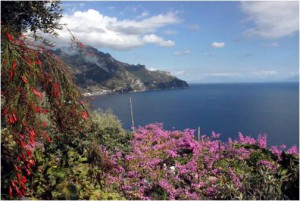 Eager to see the sites of Antiquity themselves, architects, artists and their rich patrons ventured down the long road to Naples, braving brigands, mosquitoes and heat.
Eager to see the sites of Antiquity themselves, architects, artists and their rich patrons ventured down the long road to Naples, braving brigands, mosquitoes and heat.
- How did they travel?
- What would they see and do in 18th-century Naples?
- Which sites would they visit?
- Where would they stay?
With this post, Regency Explorer provides a travel guide to the ‘Kingdom of Naples and Sicily’ for travellers of the Romantic Age.
The destination: Facts and Figures
Population & Economy
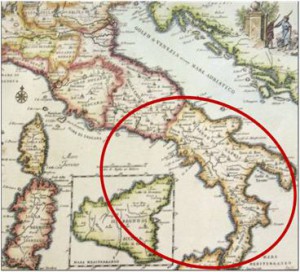 The territory of the Kingdom of Naples and Sicily covers South Italy from the provinces of Campania and Molise to Calabria and Sicily. It is a fast-growing country. The number of inhabitants sums up to 3.5 million in 1750, and to 5.0 million in 1800.
The territory of the Kingdom of Naples and Sicily covers South Italy from the provinces of Campania and Molise to Calabria and Sicily. It is a fast-growing country. The number of inhabitants sums up to 3.5 million in 1750, and to 5.0 million in 1800.
The economy is based on agriculture and trade. The kingdom exports e.g. saffron, oranges, lemons, wine, brandy, wheat, barley, oil, silk, wool, cotton, metals, brimstone and salt. It imports from England e.g. fans, canes, hats, furniture, clocks, watches, lead, tin, fish, cocoa, tea, coffee, pepper, and sugar.
Arms and ironworks factories are founded from about the mid 18th century, and bridges and roads are built to improve trade and to prepare for war.
The economy is controlled by feudal nobility and foreign merchants. Thus, mainly the regional lords profit from trade. The rural population is poor and indebted.
Politics & War
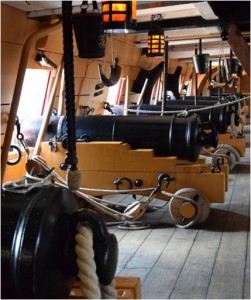 Travellers should be aware of the tense political situation of the Kingdom of Naples and Sicily from about 1789. As a consequence of the French Revolution, the police are enforced and closely monitor persons suspected of liberal ideas. The situation gets instable from 1793, when the kingdom enters the alliance against France. Napoleonic France is a constant threat, and the whole royal court, British diplomats and British residents have to flee from invasion twice.
Travellers should be aware of the tense political situation of the Kingdom of Naples and Sicily from about 1789. As a consequence of the French Revolution, the police are enforced and closely monitor persons suspected of liberal ideas. The situation gets instable from 1793, when the kingdom enters the alliance against France. Napoleonic France is a constant threat, and the whole royal court, British diplomats and British residents have to flee from invasion twice.
The Queen and her English Advisor
Since 1735, the kingdom is ruled by a cadet branch of the Spanish Bourbons. As Ferdinand IV of Naples prefers hunting to politics, his wife, Maria Carolina (of Austria), is in charge of the state affair. She is a clever woman, and she also knows when to seek the assistance of advisors. The Englishman Sir John Acton is in her service since 1779. He greatly influences politics, improves the economy and remodels the navy of the kingdom. He later also serves as minister of finance and as prime minister.
Napoleon Strikes!
In 1798, Napoleon’s troops invade the kingdom. Ferdinand, Maria Carolina and Sir John Acton flee from Naples to Sicily. For several months, the Kingdom of Naples and Sicily is a republic, but it is regained for the Bourbons by Horatio Nelson in 1799.
In 1806, Napoleon strikes again. An invasion force led by his brother Joseph seizes the kingdom. Ferdinand, Maria Carolina and Sir John Acton flee to Sicily again. Joseph Bonaparte rules as king of Naples for two years.
In 1808, Napoleon decides to make his brother-in-law, Joachim Murat, king of Naples.
Murat proves to be a popular choice with his subjects: He abolishes feudalism, dismantles the privileges of the churches, reorders the courts, sets up schools and has Naples lighted by oil lamps at night.
Ferdinand Rules – or so
With Napoleon’s downfall in 1815, the kingdom is returned to the Bourbons once again. As Maria Carolina and Sir John Acton have passed away, it is finally up to Ferdinand to rule. He tries to do so as an absolute monarch. This soon sparks rebellion. In 1820, a military revolt breaks out. As a consequence, Ferdinand has to sign one of the most liberal constitutions of the continent. However, with the assistance of the Austrian army, the liberal forces are suppressed and the constitution is declared null and void only a year later. Parliament is dismissed, and Austria takes over the kingdom’s domestic and foreign policies.
Getting There & Around
When to Go
It is advisable to pass the Alps in September, before it starts to snow. Going earlier is considered dangerous with regards to passing the Apennines. They are malarial territory in the hot summer months. Its only with the rains in September that the air is purified and the noxious vapours that hover over the marches along the roads are allayed. January to March are considered excellent months for staying in the kingdom of Naples and Sicliy.
Documents and Letters of Recommendation
For entering the Kingdom of Naples and Sicily, travellers need a passport. In Italy, it can be obtained from the Neapolitan Ambassador in Rome.
It is advisable to carry letters of recommendations as introduction to the fashionable society of resident Englishmen in Naples. Otherwise, a traveller might find himself excluded from suppers, balls and genteel company.
How to Travel
Generally, the Kingdom of Naples can be reached by ship or land. The journey from England takes several weeks. The French Revolution, and, later, the Napoleonic Wars, makes travelling even more difficult, dangerous and expensive.
By Ship
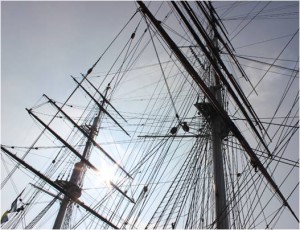 Travellers can take a ship from Marseille, Genoa, Leghorn or Ostia (near Rome) to Naples. The duration of the trip depends upon the weather. Henry Swinburne’s journey from Marseille to Naples took 12 days in 1776. The trip from Ostia can be completed in 24 hours when the weather is fine.
Travellers can take a ship from Marseille, Genoa, Leghorn or Ostia (near Rome) to Naples. The duration of the trip depends upon the weather. Henry Swinburne’s journey from Marseille to Naples took 12 days in 1776. The trip from Ostia can be completed in 24 hours when the weather is fine.
Going from Ostia to Naples by passenger ship costs about 5 crowns, board included.
During the war, passenger ships are not in service. Travellers might travel on a war-ship by special government permission, or should have naval connections at their disposal, e.g. via high ranking members of the navy in their family. The adventurous traveller also might sail with a smuggler or privateer.
By Carriage
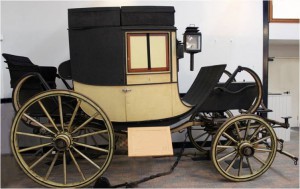 A direct road connects Rome and Naples. The journey of more than 200 km takes at least two days, but most travellers take the chance to visit the towns along the way. Thus, they reach Naples in about 5 to 7 days.
A direct road connects Rome and Naples. The journey of more than 200 km takes at least two days, but most travellers take the chance to visit the towns along the way. Thus, they reach Naples in about 5 to 7 days.
Luckily, the main road to Naples is reasonably good. There are, however, only a few inns to stop and change horses. Changing horses costs 16 Carlini per pair at the post stations. Additional 3 Carlini are due to the postillion (for more information about money see part 2).
Roads leading into the countryside are in a bad condition. For navigating the narrow, curvy streets, a two-wheeled gig drawn by one horse is the most convenient vehicle, but often the roads are only passable by horse or even by mule.
Maps & Guidebooks
For orientation in Naples, travellers for a long time had to rely on a map from 1628. As the city has changed drastically since then, the map has its limitations. A new map is finally available from 1750.
Guidebooks and travel descriptions are available, but they are based on journeys of the 1720ies and 1750ies. The most recent work is Henry Swinburne’s travel description about his travels in South Italy in the late 1770ies. It is published in 1783.
The first bi-lingual guidebook about Naples and its surroundings is published in 1817 by Giovanni Mazzinghi. He also offers Italian classes for English travellers (6 Carlini per lesson). You can read the guidebook online here.
Things to See & Do
Naples – Capital of the Kingdom
In the Romantic Age, Naples is Western Europe’s third largest city. It has about 400,000 inhabitants in 1800. It is by far the biggest city of the kingdom, and as cultural and science strive, it is the main destination for travellers.
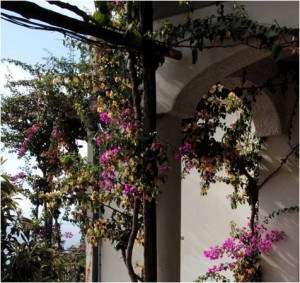 British visitors love the exotic flair of Naples: The streets are paved with slabs of lava from Vesuvius. The houses feature terraces and flat roofs with pots of roses, jessamine and oranges.
British visitors love the exotic flair of Naples: The streets are paved with slabs of lava from Vesuvius. The houses feature terraces and flat roofs with pots of roses, jessamine and oranges.
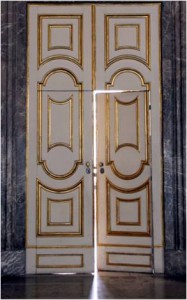 Dedicated sightseers can visit hundreds of churches and chapels or marvel at the Royal Palaces at Capodimonte, Portici and Caserta. The Royal Palaces are open to visitors when the King is not in town.
Dedicated sightseers can visit hundreds of churches and chapels or marvel at the Royal Palaces at Capodimonte, Portici and Caserta. The Royal Palaces are open to visitors when the King is not in town.
Click here for a virtual visit to the Royal Palace of Caserta and for gossip about the social elite and nobel British travellers frequenting the palace.
Neapolitan Dolce Vita
The seductive beauty of South Italy performs a powerful charm on early tourists. Under the liberating southern sun a relaxed way of life takes over. Gone is the goal to see each and every important church and museum, as it was the standard procedure for Rome. Naples is a paradise in which every tourist lived in “intoxicated self-forgetfulness” (as Goethe called it). The myth of a carefree people in a land of plenty seems to be real.
Instead of keeping up a strict schedule for sightseeing, most tourists are happy with simply strolling along the streets and enjoying the South Italian Way of life.
“It is extremely entertaining to drive about the streets to see how very unlike everything is to what we see at home”, writes Georgiana Carolina Fox, 1st Baroness Holland, to her sister.
The best places to do so are the fashionable street Strada di Toledo and the promenade Chiaja. Here, tourists can watch the Neapolitan high society driving around in their open carriages in the evening.
The easy-going life is mainly responsible for Naples’ reputation as a hedonistic, pleasure-seeking city. It is considered a second Venice, without the heavy gambling and the blatant prostitution.
Balls, Suppers and Assemblies
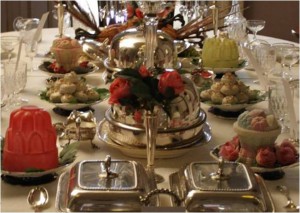 Social entertainment includes hosting balls, card parties and suppers for other British travellers. The heart and soul of the British society in Naples is Sir William Hamilton, British Consul to the Kingdom of Naples and Sicily from 1764 until 1800. He entertains high-ranking travellers at the Palazzo Sessa. Mrs Hamilton gives a musical assembly once a week. Being invited by the Hamiltons offers the rare chance to actually meet the Neapolitan society or famous foreigners such as Giacomo Casanova, Johann Wolfgang von Goethe or the budding musical talent Wolfgang Amadeus Mozart. Additionally, Sir William’s famous collection of Roman, Greek and Tuscan antiquities is a “must-see”.
Social entertainment includes hosting balls, card parties and suppers for other British travellers. The heart and soul of the British society in Naples is Sir William Hamilton, British Consul to the Kingdom of Naples and Sicily from 1764 until 1800. He entertains high-ranking travellers at the Palazzo Sessa. Mrs Hamilton gives a musical assembly once a week. Being invited by the Hamiltons offers the rare chance to actually meet the Neapolitan society or famous foreigners such as Giacomo Casanova, Johann Wolfgang von Goethe or the budding musical talent Wolfgang Amadeus Mozart. Additionally, Sir William’s famous collection of Roman, Greek and Tuscan antiquities is a “must-see”.
Culture & Entertainment
Theatres and Opera
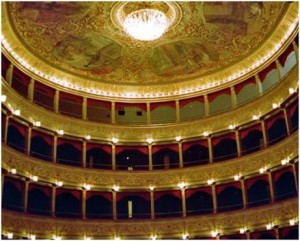 Naples rivals Venice in the field of opera productions. Many musical stars train at the opera houses of Naples, among them the famous castrato singer Farinelli.
Naples rivals Venice in the field of opera productions. Many musical stars train at the opera houses of Naples, among them the famous castrato singer Farinelli.
The Teatro di San Carlo is the biggest opera house in the world. It features 184 boxes arranged in six orders, and, standing room included, can hold over 3,000 people. Its gold decorations and the sumptuous blue upholstery are much admired. It has, however, a poor reputation with regard to acoustics. Nevertheless, travellers love going there to watch the fashion and manners of the local elite.
From 1790, the aristocratic audience prefers to visit the newly opened Teatro San Ferdinando.
For travellers with a taste for lighter entertainment, the Teatro del Real Fondo di Separazione, opened in 1779, offers mainly comical operas.
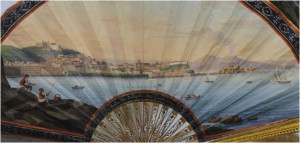 Nature & Activities
Nature & Activities
Naples is famous for its beautiful bay with the majestic Mount Vesuvius in the background. Bay and volcano are the motif for souvenirs, be they paintings or fans.
Climbing Mount Vesuvius
The volcano is among the principal attractions of the kingdom, as it erupts periodically.
Traveller Sir Francis Haskins Eyles-Stiles, 3rd Baronet, notes:
“The mountain, which was quiet in the morning, with scarce any visible smoke, threw up on a sudden, about noon, a vast column of black, which rose to a very considerable height; and, before it had diffused itself, made a splendid and glorious appearance, as the sun, which was shining, gilded the superior part of it; but soon after, it dispersed, and covered all the mountain, and a great portion of the sky in that quarter. The ashes, that fell from it, resembled the falling of a heavy shower, seen at a distance, and must have done great mischief, if any living thing was under them.”
Authoress Hester Thrale writes about Mt. Vesuvius in 1786:
“ … When in the silent night, (…), one listens to its groaning, while hollow sighs, as of gigantic sorrow, are often heard distinctly in my apartment, nothing can surpass one’s sensation of amazement . . .”
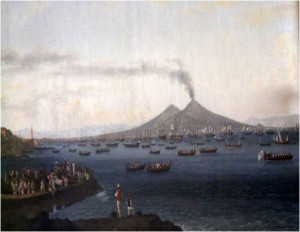 Many travellers, among them Georgiana, Duchess of Devonshire, Caroline Princess of Wales, and gothic novelist Ann Radcliff, climb the volcano. They are rewarded with a view of the smoking crater and findings of new lava. Occasionally, the volcano ejects pieces of rocks. In this case, a quick retreat is advisable.
Many travellers, among them Georgiana, Duchess of Devonshire, Caroline Princess of Wales, and gothic novelist Ann Radcliff, climb the volcano. They are rewarded with a view of the smoking crater and findings of new lava. Occasionally, the volcano ejects pieces of rocks. In this case, a quick retreat is advisable.
By the early 19th century, taking travellers to the crater has become a veritable business. Guides with mules wait for customers in Portici, at the foot of the mountain, and when the price for the tour has been negotiated, the tourists party sets out for the volcano adventure.
The crater can only be reached by food. It is a steep climb. This is the moment when the gentlemen rid themselves of their coats, cravats and even their waistcoats. They continue the ascent in shirtsleeves. At every step, their feet sink into ashes and slide back.
Ladies are believed to be too delicate to climb up the mountain. They are taken to the top on chairs carried with poles on the shoulders of peasants.
Travellers should be aware that an excursion to the very top of the volcano is best accompanied by an armed soldier or policeman. Despite the remote location, the rich visitors are a temptation for brigands, and several robberies have been committed on the crater.
Watersports
Sea-bathing
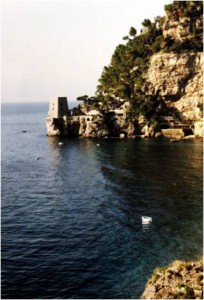 Swimming in the bay of Naples is a popular sport among visitors. The travelling preceptor for noble British gentlemen, Patrick Brydone, writes:
Swimming in the bay of Naples is a popular sport among visitors. The travelling preceptor for noble British gentlemen, Patrick Brydone, writes:
“Sea-bathing we have found to be the best antidote against the effects of the sirocco; and this we certainly enjoy in great perfection. Lord Fortrose, (…), has provided a large commodious boat for this purpose. We meet every morning at eight o’ clock, and row about half a mile out to sea, where we strip and plunge into the water […]. My lord has ten ‘watermen’, (…) (to) go in with us, to pick up stragglers and secure us from accidents. They dive with ease to the depth of forty, and sometimes of fifty feet, and bring up quantities of excellent shell-fish […]. After bathing we have an English breakfast at his lordship’s (…)”.
Sailing
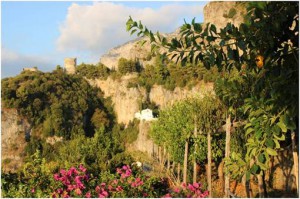 Some visitors hire sailing boats and discover the coastline. They sail to Sorrento and sometimes even as far as Amalfi. Admiring the natural beauty of the coast is the main object of the cruise.
Some visitors hire sailing boats and discover the coastline. They sail to Sorrento and sometimes even as far as Amalfi. Admiring the natural beauty of the coast is the main object of the cruise.
However, Amalfi is famous for handicrafts such as coral-work, goldsmith’s art, and especially the production of finest paper. 20 paper mills are active in the village. Travellers dedicated to art might buy a stack of quality paper. You can read an article about historical paper-making here . King Joseph Bonaparte visits the village in 1807. He is so charmed by the beauty of the place that he initiates building a road between Naples and Amalfi (the road is, however, only finished in 1854).
Continue reading: “Writers Travel Guide: The British and the Grand Tour to the Kingdom of Naples (Part 2):
- The Antiquities Trail
- Dangers and Annoyance
- Practical Tips for Travellers
Find more posts of the Writer’s Travel Guide-series here.
Sources
- Swinburne, Henry: Travels in the two Sicilies; London, 1783.
- Brydone: A Tour through Sicily and Malta; London, 1776.
- Carlo Knight, “Sir William Hamilton’s Neapolitan houses”; Link: http://www.herculaneum.ox.ac.uk/?q=knight#_ftn20
- Mazzinghi, Giovanni: Guida alle antichita, e alle curiosita nella citta di Napoli e nelle sue vicinanze, etc. – A Guide to the Antiquities and Curiosities in the City of Naples and Its Environs; Naples, 1817.
- Nugent, Thomas: The Grand Tour – containing an exact description of most of the cities, towns and remarkable places of Europe, Volume 3; London, 1749.
- Wright, Edward: Some observations made in travelling: through France, Italy, &c. in the years 1720, 1721 and 1722; London, 1730.
- Northall, John: Travels through Italy, containing new and curious observations on that country, etc; London, 1776. (Based on a trip in the 1750ies)
- Rev Chetwode Eustace, John: A tour through Italy: exhibiting a view of its scenery, its antiquities, and its monuments, particularly as they are objects of classical interest and elucidation : with an account of the present state of its cities and towns : and occasional observations on the recent spoliations of the French, London, 1813, Volume 1 and 2
- Lady Campbell Bury, Charlotte: The Murdered Queen! Or, Caroline of Brunswick: A Diary of the Court of George IV; London, 1838.
- Black, Jeremy: The British Abroad: The Grand Tour in the Eighteenth Century; The History Press, 2003.
- http://www.mytravelsinitaly.com/amalfi/
- http://www.encyclopedia.com/topic/Kingdom_of_Naples.aspx
Article by Anna M. Thane, author of the novel
“Von tadellosem Ruf” (http://amzn.to/2TXvrez)
